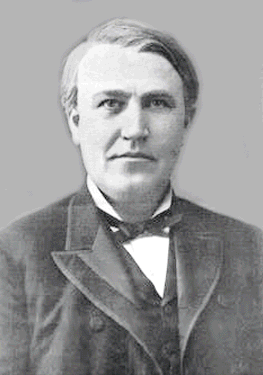
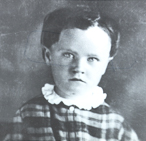
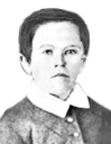
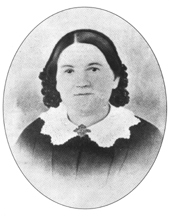
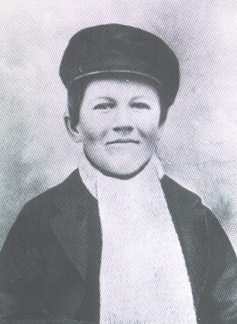
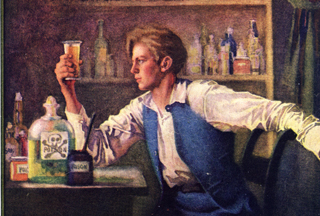
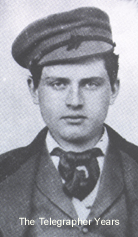
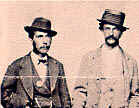
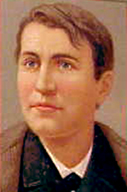
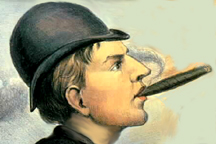

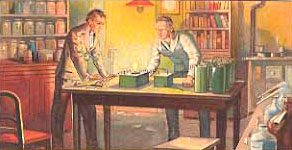
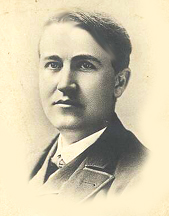
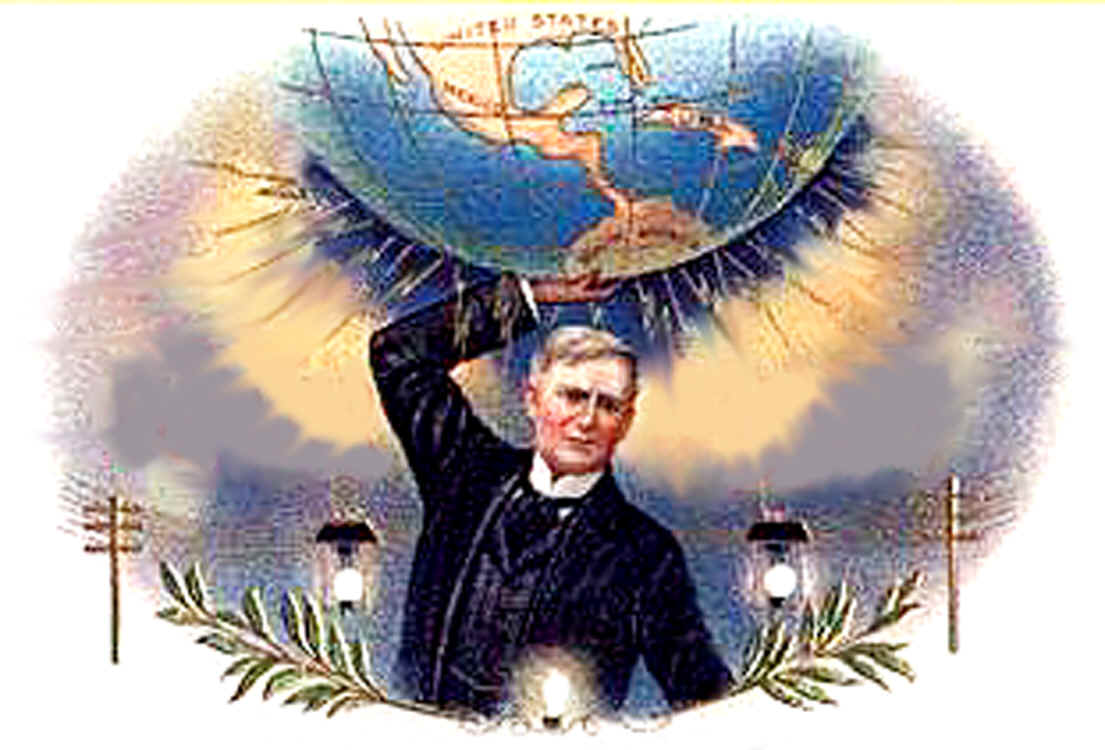
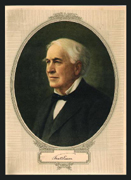
Thomas Alva Edison

"The miracle of the millennium was converting fuel into safe and
affordable electric light and motor power for the masses. The first to
envision and construct a practical model for achieving this elusive goal
was Thomas Alva Edison"
FROM COAL TO KILOWATTS
"Although Thomas Edison certainly deserves the lion's share of credit
for 'lighting up the world,' this amazing accomplishment was far less
related to his particular discovery of an incandescent bulb than to his
creation of the first genuinely safe and economically viable system for
generating and distributing light and power, worldwide."
"THE VAST MAJORITY OF MODERN HISTORIANS STILL PRIMARILY ASSOCIATE THOMAS
EDISON WITH THE INCANDESCENT LIGHT BULB - WHICH HE DIDN'T INVENT - AND A
DRAMATIC HANDFUL OF THE 1093 THINGS HE ACTUALLY DID INVENT. MEANWHILE,
THEY VIRTUALLY IGNORE THE MUCH GREATER SIGNIFICANCE OF HIS FIRST
"FINISHED" MODEL OF A UNIVERSALLY PRACTICAL CENTRALIZED POWER STATION.
THE COMPLEX SCIENCE THAT LED TO THIS INCOMPARABLE TECHNO/CULTURAL
BREAKTHROUGH CONJOINED OUT OF SEVERAL SMALL 'IDEA FACTORIES' EDISON
EVENTUALLY ORGANIZED INTO THE WORLD'S FIRST RESEARCH AND DEVELOPMENT
CENTER.
INTRODUCED AS A TWO WIRE SSTEM IN 1879 IN MENLO PARK, NEW JERSEY AND
VERY MUCH DEVELOPED AND DEMONSTRATED ELSEWHERE, THE FIRST "COMPLETE"
SYSTEM FOR CENTRALLY GENERATING AND DISTRIBUTING ELECTRICITY DID NOT
COME TO FRUITION UNTIL 1883, IN BROCKTON, MASSACHUSETTS.
CONCEIVED 11 MONTHS EARLIER, AT THE TIME HE WAS INSTALLING AND MODELING
INCANDESCENT LAMP ILLUMINATION IN A TINY SECTION OF NEW YORK CITY,
EDISON'S BREAKTHROUGH BROCKTON FACILITY FEATURED A STANDARDIZED
THREE-WIRE GRID AND ASSOCIATED FEEDERS. EVENTUALLY, IT PROVED CAPABLE OF
SAFELY AND ECONOMICALLY DELIVERING LIGHT AND POWER TO UP TO 20 SQUARE
MILES. FOR THE FIRST TIME, THIS MEANT IT WAS THEORETICALLY POSSIBLE TO
PROVIDE COMMUNITY-WIDE ELECTRICAL SERVICE TO HUNDREDS OF THOUSANDS OF
VILLAGES AND SMALL CITIES THROUGHOUT THE WORLD.
RECOGNIZED BY THE FEW SAVVY ELECTRICIANS THEN IN EXISTENCE AS THE MOST
IMPORTANT ADVANCE TO EMERGE OUT OF THE AGE OF ELECTRICITY, ITS FEATURES
WERE MIMICKED IN EUROPE AND THE UNITED STATES FOR OVER A DECADE.
MEANWHILE, EDISON'S EAGER PROMOTERS REMAINED SO FOCUSED UPON
POPULARIZING HIS WAVERING SUCCESS IN REPLACING GAS LAMPS WITH
INCANDESCENT LAMPS IN A ONE BLOCK AREA OF THE "BIG APPLE," THEY
EFFECTIVELY DIMINISHED THE HISTORIC SIGNIFICANCE OF HIS EFFORTS
ELSEWHERE, MOST ESPECIALLY IN BROCKTON.
AND AS HE WAS DESPERATELY TRYING TO FULFILL THE EXTRAVAGANT STATEMENTS
FINANCIAL COHORTS, WHO WERE PROCLAIMING HIS REMARKABLE - BUT ALREADY
OUTDATED - TWO WIRE NEW YORK FACILITY WAS A PERFECT SYSTEM, EDISON WAS
EVEN FAILING TO ATTEND TO SOME OF THE BASIC SOCIAL NEEDS OF HIS
FAMILY....
IN ANY CASE, THE HUGE CULMINATING ROLE THAT HIS BROCKTON PLANT PLAYED
DURING THE EXTREMELY INTENSE RACE TO DEVELOP - IN THE MASTER'S OWN WORDS
- "THE FIRST PERFECT AND COMPLETE CENTRALIZED ELECTRICAL POWER PLANT"
WENT RELATIVELY UNNOTICED.
AND EVEN THOUGH EDISON AND HIS SON CHARLES EVENTUALLY ACKNOWLEDGED THAT
BROCKTON' REVOLUTIONARY 3-WIRE, FEEDER OPERATION WAS INDEED "THE FIRST
TO SHOWCASE THE FINISHED EDISON SYSTEM," THIS WELL DOCUMENTED FACT
REMAINS RELATIVELY UNKNOWN. THE SAME CAN BE SAID ABOUT THE FIRST
COMPLETE APPLICATION OF ITS SAGACIOUS DESIGN BEING A COLLECTIVE
REPRESENTATION OF THOMAS EDISON'S CROWNING ACHIEVEMENT....
The Details Associated With Edison's Singular Technological Breakthrough
in Brockton, Massachusetts
Registered and Copyrighted © by Gerald Beals Feb. 11, 1997 - All Rights
Reserved. WARNING: All text and images on this site are registered and
copyrighted by the author . Accordingly, they are not to be printed for
distribution or electronically reproduced in any form without his
express written permission..
"Satisfied with the concepts embodied in his new standardized 3-wire
feeder system in Brockton, ("smaller is sometimes more efficient")
Edison returned to working on entirely new areas of invention.
Meanwhile, he clung to his then only partially flawed argument that -
until it was absolutely proven otherwise - DC current was far more
humane than AC current. In any case, the mitigating synchronic features
- which were first introduced in Brockton's electrical power generation
and distribution system - represented the consummation of a four year
quest and the very acme of Edison's career..."
New England "the Silicon Valley of the 19th Century" was the home of
America's Industrial Revolution. Although rarely remembered and even
more rarely understood, one of the most important events in
technological history took place from 1882 through 1885 in this tiny
Northeastern corner of the country. There was simply nothing else like
it anywhere....
The tremendous affect electricity has had upon the natural environment
and mankind's "built" environment can not be accurately assessed by
limiting the focus to such amazing, but highly specialized, inventions
as the light bulb, telephone, phonograph, generator, motor, and motion
picture camera. All of which were at least partly invented by Thomas
Edison....
Evaluating this broad techno/cultural domain and the first integrated
electrical generation and distribution system to prove it could safely
provide cheap illumination and power for everyone is best initiated by
becoming familiar with Edison's seminal work in developing both isolated
(on-site) and centralized power plants....
Throughout most of 1882, Edison was wrestling with the complex challenge
of transcending the experimental stage of the centralized production and
distribution of commercial electricity, ever hoping to "perfectly and
completely" harness it and make it a benefit to all. Finally, in the
Fall of that year, he came up with the first grid capable of truly
achieving that end.
Contrary to popular perception, he did not take this last major step in
New York City. The consummate design of his famous "Edison system"
materialized until 11 months later in the progressive little shoe-making
community of Brockton, Massachusetts.
Even though this Brockton prototype initially used less power than would
now be required to light the bulbs on a modern Christmas tree, its
overarching technology stunned the handful of scientists who first saw
it, especially England's Samuel L. Insull. Until now, he and other
critics - such as the great Lord Kelvin - had been continuously pointing
out the limitations of Edison's seemingly insurmountable goal of
economically lighting and powering the world via electricity, vs. gas.
Unfortunately from an historical perspective, at this juncture a number
of 19th Century Madison Ave. types stepped in and convinced Edison and
his supporters to somewhat downplay the Edison Corporation's success in
Brockton. Their primary rationale was to maintain and enhance media
focus upon his far from complete facility in New York City. And even
though Edison had initially expressed great pride in his breakaway
accomplishments in Brockton, calling the operation "My first showcase
system" and "My first complete system," he fully concurred with the
economic practicality of putting the most positive spin possible on his
legitimately great efforts and accomplishments in New York.
Accordingly, the press was often so obsessed with alternately touting
and critiquing the sensational public relations releases coming out of
Manhattan, the majority of them ignored - more likely never grasped -
the enormous significance of what was co-transpiring in Brockton....
In any case, most contemporary and later historians barely noted the
fact that it was the Brockton effort that finally eclipsed the major
stumbling blocks Edison had been previously encountering in his
experimental models in Madrid, Paris, Milan, London - and New York.
Contributing to a further blurring of the historical record, all of the
Edison Illuminating Light Corporation's engineering plans and
correspondence relating to Edison's Brockton venture were destroyed in a
mysterious fire...
As a result of the above factors, the fascinating history associated
with Brockton’s critically significant involvement in the world shaking
techno/cultural event of perfecting public electrification has been
pretty much expunged. Nevertheless, several heretofore remote details
relating to this history were recorded for posterity, not only by local
citizens but by some of the world's most sophisticated scientists of the
time.
More specifically, the writer has uncovered several accounts recorded by
famous, and not so famous, observers who were keenly aware of the
potential for the globalization of electricity. The following is
herewith presented in the hope of adequately addressing the above
"historical oversight."
THE DETAILS OF EDISON'S FABULOUS BREAKTHROUGH IN BROCKTON, MASSACHUSETTS
Excerpted from Chapter 3 of "The Development Of Early Power Plants
Throughout The World"
With special permission from the author
Copyrighted © and registered by Gerald Beals 2/11/97
All Rights Reserved
1882 - 1883 "I never perfected an invention that I did not think about
in terms of the service it might give others..." Thomas Edison
The specific impetus that led to Edison's breakthrough in developing his
first genuinely practical electrical power system emanated from the
critically significant technical and economic problems he had long been
experiencing with his 2-wire demonstration stations in Paris, France and
Milan, Italy, etc. More importantly, it evolved out of some of the
menacing problems he was continuing to have with similar - but also "far
from complete" - facilities he was trying to perfect in London, England,
Appleton, Wisconsin, Sunbury, Pennsylvania, and New York City.
Even though the mass-produced "free" light bulbs Edison had felt obliged
to provide his earliest customers at this time had attained a relatively
high level of efficiency and durability, the relatively unsafe, crude
and inflexible means by which current was still being produced and
distributed to them left a very great deal to be desired. More than
occasionally, for example, wire resistance and accompanying voltage
drops in the New York facility - which had to be very carefully
monitored and constantly "tweaked" by electricians - were resulting in
"black days." Meanwhile, as both customers and workers were sometimes
being killed by the extant Edison system, his light bulbs - vs. the
above systemic imperfections relating to the economic and safe
generation and distribution of electricity - were were being incorrectly
perceived by both the general public and many experts as the primary
culprit....
A somewhat shameless shortcoming of this period in Edison's career was
that, even though he clearly knew better, he continued to promote his
still far from perfect New York plant as an entirely viable model for
world-wide commercial use. But even with its truly marvelous "Jumbo"
generator and underground wiring, etc., it contained the flaws and
associated pretensions inherent in all of his existing 2-wire feeder
high strain operations..
Another key point to keep in mind here is that, until Edison designed
his Brockton, Massachusetts facility, none of his previous plants - all
of which by his own admission were experimental - were theoretically
capable of transmitting economically viable quantities of electrical
power for more than a couple of thousand feet from a generating station.
And of course, Edison well realized, they were theoretically and
practically incapable of servicing the unique configuration patterns of
the vast majority of the communities then emerging throughout the modern
world.
Interestingly, the challenge of perfecting a system that would be
practically and universally satisfactory to all of humanity at this time
was so great that some of Edison's sophisticated backers tried to
convince him to switch his focus back to enhancing his already highly
successful isolated (on-site) 3-wire operations. But wisely, the world's
master of invention remained convinced it was would be unfeasible to try
universalize electricity by collectively sub-regionalizing such
methodology.
Fortunately, all of this incertitude was marvelously eradicated when the
irrepressible young inventor came up with the design for his first
standardized, centralized 3-wire feeder system - in Brockton. It was
also diminished by the fact that the manifestation of this remarkable
new system of inventions was later hailed by a handful of his worst
critics as "a most sagacious achievement...."
The specific details relating to Edison's development of his Brockton
fait accompli are of heroic proportion. The saddest aspect of this most
prolific period in his life was that, while he was being hammered at
every turn by fierce critics and cutthroat competitors, he was being
constantly plagued by the illness and impending death of his beloved
wife.
For example, as reporters from prominent newspapers - including the New
York Times - were gleefully lampooning him and eminent scientists were
questioning his ability to come up with a truly viable substitute for
the gas lighting industry, the shrewd owners of the latter organization
were constantly trying to find ways to divert, undermine, and, or,
co-opt him. But while most men would have been rattled by these
circumstances, this implacable young genius remained sharply focused
upon his short term goals and his long range mission.
A related quote from Volume 134 of Edison's 3,400 diaries reveals the
extraordinary intensity of his commitment in the following terse manner:
"Object, ....to effect imitation of all done by gas, so as to replace
lighting by gas by lighting by electricity...."
Obviously passionately dedicated to capturing the world market for
electricity, it is not surprising that Edison remained doggedly obsessed
with making a popular success out of his humongous 2-wire experiment in
the Pearl Street section of lower New York City.
(Most likely, it would not have greatly surprised him that, with more
than a ten trillion kilowatts per year of current output, electricity
has become the most consumed commercial product in existence. In the
U.S. alone, for example, there are presently over 10, 000 central power
plants producing over a quarter of a trillion dollars worth of
electricity each year. )
In any case, in July of 1882, a few months before Edison officially
opened his far from complete "Manhattan leviathan" - in what was then
the worst slum section in town - he was suddenly confronted by one of
the most competitive challenges of his career....
Similar to what frequently happens to rivals in the current rapidly
changing world of electronics, a British scientist/educator by the name
of Joseph Hopkinson announced he had discovered a fundamentally new and
better method of "making and delivering" electricity. It turned out that
he had been hired to make a formal evaluation of Edison's first attempt
to establish a commercial facility in London, but had also also been
covertly doing a lot of "fooling around" with it. (Editor's note: A good
deal of Edison's work in his famous New York plant was based upon the
commercial theories and technology he had worked out in this preceding
London facility.)
The essence of Dr. Hopkins’ claim was that his overarching 3-wire
concept represented a dramatic improvement over the Edison system of
parallel 2-wire feeder circuitry.... Specifically, he claimed that,
along with Edison's state-of-the-art feeders and transformers, such
multiple wiring could safely deliver both low, and relatively high,
voltage to 16 times more area than any of Edison's existing systems He
also guaranteed it would eliminate over 60% of the copper wire that was
then being "wasted" in all such facilities, producing much lower
overhead in running a centralized plant.
While Hopkins' former claim, may have been the most astonishing and
threatening, Edison and his cohorts did not take the latter allegation
lightly. At the time, the United States was still years away from
developing its own copper mines and a "cabal" of French speculators was
seriously threatening to corner the world's copper market.
Meanwhile, Germany's great inventor, Woerner Seimen's, was not only
tinkering with his own version of a safe, commercial three-wire system,
he was also working on developing an "artificial" method of
inexpensively producing copper out of chemical solutions....
Making a long story very short, Edison now forged one of the sweetest
deals in history when he co-opted Hopkins 3-wire technology for himself
and the Edison Illuminating Light Corporation, and combined it with the
latest in feeder and transformer technology....
Interestingly, even though this shrewd acquisition would prevent his
formerly "wildly ambitious" goal of electrifying the world from being
brought to fruition by Englishmen, he was forced to waver on employing
it in New York. One of the reasons for this was that his beleaguered
supporters and crews had already installed over 60 tons of the "old"
type of 2-wire wiring (or 90% of the planned total of 70,000 feet)
beneath the streets of this city. Another factor was that his
experiments in validating three-wire technology still needed a good deal
of "practical perfecting."
The main reason for his equivocation, however, was that - even though he
realized his "copper-bound Manhattan behemoth" was already outmoded by
3-wire feeder and transformer technology - Edison's chief investors were
in no mood to spend any more money or waste any more time in completely
reconstructing this seminal operation.
So as gas and arc-light industry "sharks" continued to sniff at New
York's free wheeling and contentious business atmosphere - hoping to
catch the scent of the upstart inventor's blood - Edison and his
advisors countered by maintaining that his 2-wire operation on Pearl
Street was already a "complete success."
Convinced that even limited efficacy in this important metropolis would
command world-wide publicity, he specifically followed the advice of his
noted public relations expert, William J. Hammer, and engendered the
basically false impression that "everything that could possibly be
accomplished in perfecting universal centralized electricity was already
nearing completion in New York City."
Meanwhile, neither the press, the public, nor most of Edison's
financiers (excepting the omniscient J. Pierpoint Morgan) were aware
that he had committed himself to concurrently developing - elsewhere - a
far more efficient and competent little standardized 3-wire underground
alternative to his New York facility.
Amazingly, from late 1882 through early 1883, Edison not only exerted a
great deal of energy upon developing his 2-wire New York facility, and
in patenting several significant unrelated ideas ,but in conquering the
myriad of problems associated with 3-wire technology.
As for the latter concern, he specifically blended Hopkins’
revolutionary 3-wire concept with the equally dramatic breakthroughs in
3-wire feeder and transformer technology that were being concurrently
achieved by his brilliant engineer/assistant, Frank Sprague.
The remarkable outcome was the first successful network of parallel
supply conductors to incorporate feeders produced the world's first
genuinely "smart grid" in Brockton. Meanwhile, during this most intense
and creative period of his life, Edison finally perfected the high
resistance bulbs required by his combined relatively low tension
(110-220) dual volt 3-wire system.
Remarkably, during this time, Edison also applied for what was - and
still stands - as not only "the greatest number of electrical generation
and distribution patents anyone ever produced, but the greatest number
of patents of all types ever issued to any individual or corporation
within a span of six months...."
Having finally completed the design of his "first perfect and entirely
safe and practical" system for manufacturing and distributing
electricity - and having thoroughly tested its superseding concepts in
his fantastic seminal R and D lab in New Jersey - Edison now began to
tailor it to meet the exact needs of the highly progressive little model
city of Brockton, Massachusetts... (Editor's note: Prior to this, he had
designed his first 3-wire on site system for two of the scores of shoe
factories that were located Brockton: the soon-to-become world's leader
in the boot and shoe making industry." Of course he soon determined that
they did not work with anything near the ultimate efficiency of
Brockton's coinciding centralized 3-wire plant. In fact they were only
as efficient as the popular isolated 2-wire systems of the day.)
Before proceeding, the author fully acknowledges - and indeed strongly
emphasizes - that at this time in Edison's highly emotion charged life,
he not only exploited what Hopkinson had been doing with centralized
three-wire technology in London, but he took similar "advantage" of the
expertise of many of his employees. For example, he never felt
constrained to apologize for what some claim amounted to literally
"stealing" the creativity of his mathematician, Francis Upton; his
engineer, West Point educated Frank Sprague; the esteemed electrician,
Nicola Tesla; and many others....
But before making an overly prompt and harsh judgment on the matter, the
reader should take note that Edison was not acting any different from
the way the majority of Corporate R & D types operate today, especially
towards those whom they employ.
Moreover, during the rough and tumble laissez-faire capitalistic days of
the 19th Century - which look mild in comparison to Sterling's writings
about "law and disorder" in today's world of electronics - numerous
jealous and (or) ravenous individuals were doing the very same sort of
things to him....
In any case, by the time of the onset of his beloved wife's mortal
illness, Edison's megawatt brain was being treated by the gas industry
and most of his other competitors as "fair game for the picking…." For
example, in 1881 and 1882, a crooked patent lawyer managed to "swindle"
what amounted to over a year's worth of his critically important
research....
Quite characteristically, Edison accepted this setback with aplomb.
While the unsavory incident may have made him more suspicious than ever
of the intentions of those around him, he always recalled it - and the
fact that the rascal planned to patent more than seventy of his
inventions under his own name - with far more humor than rancor. In
fact, once he had determined that the thief was in terrible financial
straits, that his family was destitute, and that he had probably
resorted to the despicable act in order to survive, Edison dismissed all
thoughts of suing the scoundrel.
Of course, there were many other young "Turks" in Edison's midst who, in
one way or another, found ways to exploit him and, or, one up him....
The most famous example, of course, centers around Tesla's and
Westinghouse's noted work with bi-polar transmission, which eventually
spooked Edison into overreacting relative to his alleged "sole
preference" for the development of direct current....
Au contraire! Edison initially did a great deal of experimenting with AC
in his earliest systems. But because he had not yet invented a
transformer, he had scores of empirical reasons to be justly fearful of
its potential danger to the public....
Edison's "ruthless exploitation" of the ingenious Frank Sprague,
however, is different matter and an especially interesting related
story. First, if Edison had not benefited from the expertise of this
brilliant young engineer/mathematician at the time he was dealing with
the Hopkins challenge, he would have probably not been the first to
transcend the empirical stage of profit-oriented centralized electrical
power on a global scale.... After all, it was Sprague's creativity in
developing a system of automatically controlling the voltage in Edison's
erratic 2-wire feeder methodology at this time and harmoniously
incorporating it into Brockton's three-wire system that was the key
factor in Edison's ultimate success in providing safe and economic
centralized electricity to all.... Nevertheless - as will be detailed
later - even though Sprague was one of Edison's most trusted employees,
he was taking as much advantage of Edison as Edison was taking advantage
of him.....
In any case, on January 30, 1883, Edison formally signed the historic
first contract to construct a 3-wire system. Eight months later, on Oct.
1, 1883, this rapidly evolving technology was formally culminated in the
plant he constructed in Brockton's village center....
Among the numerous high-powered electrical experts of the day who
attended the Brockton opening were the famous William Insull - who had
himself long been interested in making electricity available to
everyone. Also on hand, was Germany's great Woerner Siemens, who, as
indicated earlier, had not only been independently involved in dabbling
with 3-wire theory, but was equally involved in the already well
established DC and AC arc lighting industry.
Another important attendee was Elihu Thomson, who was destined to soon
establish the Westinghouse Corporation up in Lynn, Massachusetts. While
the sad story of how Edison lost out to Westinghouse will be detailed
later, it should be noted here that Thompson was the noted pioneer in
the arc lighting industry who had boldly stated only a few months
earlier that "If Edison's existing (two-wire) power plants were ever to
become widely accepted, they would promptly consume the world's
relatively meager supply of copper...." Of course, most American and
European experts heartily agreed with him.
Although Thomson had avoided attending the opening of Edison's New York
facility a year earlier - because he realized it possessed no remarkable
advantages over the previous commercial plant Edison had built in London
and because he still lacked confidence in the practicality of Edison's
2-wire feeder system - he suddenly took great interest in what going on
in Brockton. Along with other skeptics of the day, he now realized that
a genuine breakthrough in power transmission and distribution vs. the
steam engines that had been notoriously unsuccessful in smoothly
transferring energy for more than a few hundred feet via steam pipes,
drive shafts, and clumsy belts, etc. was imminent in Brockton.
Meanwhile, he and many of his cohorts were articulating that the
"centralized" electrical technology that Edison had been testing in his
New York plant, however marvelous, had still not produced any hard
evidence that sub-regional clusters of "isolated" generators weren't a
better energy option for cities than centralized power plants....
Thompson's skepticism was further exacerbated by the fact that - even as
late as August of 1883 - Edison was occasionally heard muttering to
himself that that on-site electrical generators for producing both light
and power "may still have the best chance of ultimately winning out over
the idea of centralized commercial generation and distribution."
Significantly, the success of Brockton's premier "village system"
settled this issue. Not only were the astute witnesses who first came to
see it amazed to see how well it "harmoniously integrated Edison's
latest mass-produced components, they were "electrified" by its
potential to ultimately safely and inexpensively power all of the
factories, offices and homes in the city up to four miles from the
central station and thus eventually provide every structure that lay
within its 30 square mile of area with unlimited energy from an
ingenious complex of 3-wire 110v/220v feeder, transformer and booster
systems...."
In sharp contrast to the financial challenges still being faced by the
New York City operation - which didn't turn a legitimate profit for five
more years - experts quickly realized that the lean and mean "Brockton
3-wire design" would soon be able to generate and sustain substantial
profits. Managed by as few as three men, and featuring a per-bulb charge
of only 12 cents per Kilowatt hour - which was considerably less than
the ever-changing calculations being reported out of New York City - it
is no wonder that Brockton model station had financial appeal. Not only
did it figure to eventually reap lots of cash in powering downtown areas
of countless similar emerging cities throughout the world, it also
sported the potential for making a "ton of money" from powering the
factories, residential areas, and farms that were traditionally
concentrically located around such medium sized cities.
Another of its important feature of the Brockton facility was its
beautifully simple and clean architectural design, which was sure to
appeal to countless similar emerging cities and towns throughout the
world.... Dramatically contrasting with the drab architecture of
Edison's forbidding fourth profit-oriented "money pit," in a renovated
soap factory in lower Manhattan, the heart of this "avante guarde"
operation was sited at the very center of the Brockton's prominent City
Hall Square. (Interestingly, unlike the New York plant - which was
destroyed over a hundred years ago - Brockton's historic plant still
stands.... and remains a huge potential asset to this city... See Figure
12.)
Of related interest, many of the venture capitalists who came to witness
the operation of the early Brockton station promptly realized its
speculative benefits. They were especially impressed, for example, by
its improved methods of charging and billing for electrical service.
Dramatically aware that, since its inception nine months earlier, the
Edison Illuminating Company of New York had remained in a financial bind
(In fact Edison didn't feel confident enough to send his first invoice
to a New York City customer - in the amount of $50.00 - until Jan. 18,
1883 - and was still years away from declaring a dividend,) they much
appreciated the fact that the Brockton Edison Illuminating Light's
remarkable new three-wire feeder system looked so slick it was never
going to be obliged to hand out free bulbs or free service to its
customers.
"NEW YORK HISTORY IS NOT NECESSARILY AMERICAN HISTORY"
As a result of the extraordinary amount of time and work Edison put into
promoting, and ultimately establishing America's first large scale
commercial plant in New York City - and in spite of the fact that some
of his cohorts at the New York Illuminating Company tended to ignore the
concurrent Brockton achievement - the latter facility clearly
represented a huge technological leap ahead of everything else in the
field of central generation and distribution.... Developed at the very
acme of Edison's fabulous career, it was patently obvious that the only
plants that could record economically viable profits in small to medium
sized cities throughout the world would be those employing its model
3-wire-feeder design....
Remarkably though, even as venture capitalists and contractors were
tripping over each other applying for permits that mimicked small or
medium sized Brockton-like central plants and networks, Edison always
publicly verbalized his loyalty to the idea that his New York venture
was his greatest achievement...." Perhaps this can best be understood
via recognition of his strong personal identity with the great
metropolis of New York City and its environs, as well as by considering
his persistent dream of developing a critically important long range
economic attachment to that city.
In any case, it was this fierce sense of "local patriotism" that led him
to rank as only secondary the great significance of the work he had
pioneered earlier in Great Britain and Europe and later work in New
England. But much more about this fascinating issue later...
(Editor's addendum: As public awareness of the importance of Edison's
work in Brockton dissolved ever further into the background, the Edison
Illuminating Company of New York took five more years before it was able
to evolve its Pearl Street plant into an authentic financial success....
Significantly, this did not occur until after that city began to remodel
portions of use into 3-wire/feeder operations, which Edison would have
constructed there in the first place "if timing hadn't favored building
it elsewhere."
It is also interesting to note that the Edison Illuminating Company of
New York did replace the last of its long outdated two-wire conductors
until "19 years after the village operation in Brockton had introduced
its revolutionary 3-wire facility. Of even greater significance,
Manhattan didn't get around to providing electric motors until "almost
two years after little Brockton had - albeit modestly - crossed that
threshold...."
Finally, as the great writer, John Steinbeck, once pointed out: "New
York history is not necessarily American history." The bottom line is
that Edison's patents clearly indicate that the little city of Brockton
has as much right as any city in the world to call itself "the world's
pioneer electrical city....." The convincing evidence follows....
Rare newspaper sketch of Edison at the time he was constructing his
"Brockton system"
The Specific OVERARCHING features involved In EDISON'S CENTRALIZED
ELECTRIC POWER FACILITY IN Brockton - WHICH WAS A highly complex and
comprehensive SYSTEM of inventions That Revealed his genius AS MUCH AS
anything else - are as follows:
...It was the first system to successfully integrate Edison's vastly
improved feeder lines, junctions, mains, regulators, meters,
potentiometers, breakdown switches, etc. into a standardized 3-wire
form, allowing them be far more efficiently mass produced in his
"world's first R and D factory...."
...With its safe "low strain" 110 and 220 voltage feeder system (Edison
was convinced at this time that, in order to prevent fatal shocks to
consumers, the amount of power going into homes and businesses had to
remain below 250 Volts) combined with its new three-wire design (which
had first been theorized by the great Hopkins in London and the great
Seimens in Berlin) was now able to automatically maintain "absolute"
control over the unruly flow of electrons in complex multi-use service
areas. Accordingly, it virtually eradicated the challenging balancing
act that had long been plaguing Edison's two-wire centralized plants and
greatly accelerated the universalization of public electrification....
Contrary to Edison's earlier incorrect belief that feeder lines had to
be relatively thick at the ends closest to the source of power and much
thinner at the user's ends, Sprague's system-wide application of the
first mathematically calculated, non-tapered, and "trim" feeder lines in
Brockton added enormously to its practical viability.
Edison's associated methodology for monitoring and controlling voltage
variability and calibrating feeder resistance ("spike and "drop")
enabled the Brockton plant to deliver up to three times more power to
ten times more commercial and residential area than had been the case
with all existing 2-wire operations....
Along with the potential benefits that automatic transformers would soon
began to offer, Sprague's contributions begat added savings in the cost
of copper wire over and above those savings provided by 3-wire
technology alone.
The associated system of conductors, junction boxes, insulating
materials etc. and markedly enhanced savings in the labor costs
associated with laying, maintaining, and repairing such components made
it even more economical....
Frank Sprague's first authentic electric motors and his first tests and
applications of his famed system of centrally powered electric
street-car trolley traction were constructed in Brockton.... But sadly,
the latter accomplishments - which were clandestinely brought to
fruition in early 1884 and later patented under his own name - resulted
in a serious rift between Edison and Sprague that was never entirely
resolved.... Meanwhile, Sprague's earliest small motors were being
adopted throughout scores of Brockton shoe factories.
...Its pre-transformer-age low voltage (optional 110/220 ) three-wire
design, which - regardless of its modest initial scope - was the first
the first of its type on earth to feature aesthetically pleasing
subterranean wiring, made Brockton the first place on earth to cross the
boundaries of illumination while demonstrating the safe and economical
use of lamp-socket source and non lamp-socket sources with stationary
motors and ancillary appliances on a commercial parallel-feeder
circuit....
Its improved metering technology was the first to finally overcome the
pesky problem of "meter creep" while using the 220 volt option. Compared
to the less accurate per bulb/per day billing that was still being used
in parts of the New York City operation, this feature further added to
its commercial viability....
Possessing a more efficacious system of distribution than non-feeder
parallel wiring - which had been the key arrangement associated with the
Edison's initial success in producing a practical incandescent bulb -
the Brockton system was easily adapted to the in series form of wiring
that under girded that city's long existing Pilson/Jenny arc-light
system....
By integrating his remarkable multi-arc, or divided, incandescent light
circuits, with this city's venerable undivided arc-light circuits,
Edison made Brockton the first place on earth to simultaneously power a
parallel system with feeders and in series street lighting. Unlike what
had happened in New York City and elsewhere, the Brockton Edison
Illuminating Company "promptly established a model for working
harmoniously with the long established purveyors of AC arc lighting...."
Because it required such a relatively low capital outlay and
low-interest startup costs for investors, the Brockton operation was the
key factor in ultimately enticing hundreds of financiers to explore
taking the leap into building small to medium sized centralized plants
in not only small villages and their outlying rural areas, but in
similar power webs in densely populated urban and industrial areas -
throughout the world....
Summation
To its great historical credit, the main features of the Brockton Edison
Illuminating Light And Power Company plant ended up being mimicked by
the hundreds of small plants and the much larger plants that ultimately
followed.
Shortly after correcting a pesky problem with the earliest Type H
generation, its breakthroughs were retrofitted into most of Edison's
existing (2-wire) demonstration plants and his far more numerous
isolated (on-site) plants.
Before it was destroyed by fire, even the proud and highly touted New
York plant was finally upgraded to include them. Accordingly, it most be
noted here that - considering the fact that virtually all of the 3-wire
plants that followed the design of Edison's Brockton model were showing
profits - Edison was influenced by regional braggadocio when for most of
the rest of his life he doggedly portrayed his 2-wire New York operation
as his greatest accomplishment. Beyond the strong demographic/economic
advantages of identifying with that city, this was indeed where he built
the first large scale "permanent" central electric plant in America.
Accordingly, as his son Charles once suggested to this writer, "...at
times [vs. his great accomplishment in Brockton] he may have tended to
romanticize his New York facility just a bit too early...."
In any case, the vast majority of technological historians still fail to
clearly discern the limits to what Edison actually first accomplished in
New York City - vs. what he did not accomplish there with his marvelous
Pearl Street facility. And sadly, as the years rolled by - and
centralized networks of power production and delivery became the norm in
large urban-industrial areas - the extraordinary technological and
commercial advantages wrought by Edison in the little city of Brockton
have faded into the background. And, of course, once long distance High
Voltage AC, transformers, and turbine generators, etc. came into the
scene, they were totally forgotten.
Fortunately, a little known - but highly revealing - visit to Brockton
by Edison's son Charles (in 1958) helped set the historical record
straight when he stated that his father was well aware that his ultimate
vindication with commercial centralized electric power took place in the
remote little village of Brockton. His exact recorded words were "It was
here that father first perfectly modeled and applied it....." He could
have added that it was here where some of the world's most savvy
scientists of the time - some of whom had long been severely critiquing
his father's shortcomings with centralized commercial electricity in New
York City and elsewhere - finally saw fit to unanimously express their
unreserved congratulations to him for what he had finally accomplished
and demonstrated for the benefit of all of mankind....
In conclusion, one of the most unfortunate consequences of leaving the
Brockton component out of the overall saga of electrical history is that
it has tended to render Edison's image and character more vulnerable to
critics than should be the case.... For example, those who rather
shrilly argue that Edison did not personally invent many things he gets
credit for - and that great men such as Tesla and others "were more
responsible for influencing the design of our modern world" than he -
are given unwarranted fodder for their arguments....
It is the author's conclusion that regardless of Tesla's great work (and
the great work of other electricians with AC, what Edison did when he
first introduced a successful standardized, commercially centralized
power facility in Brockton, proving that electricity could be made
practically available to all of mankind, was an insurmountable landmark
in electrical history.
Addendum: It is said that "nothing beats an original." Accordingly, the
unique features that were inherent in the Brockton central power system
certainly meet that criteria..... It is simply undeniable that - when it
was introduced in 1883 - there was no single invention or collection of
inventions on earth that demonstrated "a more comprehensive and
successful blending of art, science, technology, and commercial
viability than this one. Even when considered by itself - this most
significant accomplishment of Edison's career warrants him the
incomparably august titles: "The father of commercially successful
centralized electrical production and distribution and the most
influential figure of the millennium...."
Copyrighted © 1996 by Gerald Beals All Rights Reserved
THE DETAILED BROCKTON STORY
"THOUGH ITS SIGNIFICANCE IS STILL LARGELY MISUNDERSTOOD, IT WILL REMAIN
A MARVELOUS PROTOTYPE OF EDISON'S GREATEST ACHIEVEMENT, FOREVER."

Among the many reasons Edison chose Brockton (Brockton's Home Page) as
the ideal place to construct his first 3-wire central electric plant was
the fact that it featured a classic New England village center, was near
Boston, and was one of the most progressive small cities in the nation.
In addition, the price of gas lighting was relatively higher here than
it was in most other communities being considered.
The first formal announcement of his desire to site it here took place
in this city's newly constructed Hotel Palmer. Later called the Belmont,
the building once stood on the south-west corner of Main and Belmont
Streets. It contained 60 rooms with European style service and a
spacious oak-paneled dining hall. William L. Garrison, Jr. - son of the
famous anti-slavery leader (who preached many times in Brockton) -
resided there while acting as Edison's Massachusetts public relations
agent. Edison and several of his world famous associates (and or
competitors) - London's Preese, Berlin's 3-wire pioneer Siemans, and the
Americans, Insull, Thompson, Steiringer, Sprague, and others - also
roomed at the Palmer during various stages of the construction and
testing of the new standardized operation.
On February 6th, 1883, the Palmer Hotel was "abuzz" with interest.
Edison had engaged local technician, newspaperman, and confidante
William J. Jenks to host a gathering of Brockton manufacturers,
merchants, and politicians for the purpose of informing them about
Edison's latest brainchild. While some of those in attendance were aware
of his expensive isolated plants in Fall River's textile mills and in
Brockton's huge Keith and Douglas shoe factories, few realized that he
had decided to construct his first model plant to "demonstrate the
commercial feasibility of centrally produced light and power right there
within their midst."
Garrison and Fall River's Spencer Borden, Edison's general manager in
New England, addressed the 75 people in attendance. Things did not go
altogether smoothly. It soon became clear that a number of them were
apprehensive about Brockton being converted into some kind of an
"experimental laboratory." More specifically, although some citizens
were concerned about the aesthetic impact associated with overhead
wiring, most were worried about issues relating to safety.
For example, few skeptics could understand how it was possible to safely
hang incandescent bulbs upside down and opposite from the way familiar
gas lights and oil lamps are oriented... Others were alarmed by the
presumed threat from explosives to their homes and neighborhoods. "What
will happen if the wires or the bulbs were to blow up?" they asked.
"Could sparks leap from street-wires to houses and start fires?....
Would existing insurance policies cover such losses...?"
The audience looked to William Joseph Jenks for answers. A direct
descendant of Massachusetts' first patent holder Joseph Jencks, he and
his wife - who was Brockton's first telephone operator - had played key
roles in successfully establishing Brockton's first telephone exchange.
Jenks was also a highly skilled temperance speaker, with a reputation
for "explaining things in a thoughtful and precise manner."
Before taking questions, Jenks cited the latest statistics on fires and
asphyxiation associated with gas lighting. He then detailed how Edison'
latest 3-wire/feeder technology fully solved the problem of controlling
the erratic voltage and current that ordinarily emanated from imperfect
steam boilers and central generators, enabling stable "bite sized" units
of electricity to be safely and economically tapped into by individual
consumers up to a mile and a half away...."
A major issue was that most of the audience did not realize that it was
incandescent lighting and not some new form of arc lighting that Edison
was proposing to them..... This was because even most the so called
experts of the time believed that the subdivision of electricity was
impossible. Of course, they were basing this incorrect conclusion upon
their correct understanding that the white-hot light associated with
burning arc lights was indeed indivisible and that any such individual
or group of arc lights could not be adjusted without affecting the
brightness of all of the lights in a circuit.... What they did not
understand was that Edison's new high resistance and low surface area
filaments were vastly different from arcs....
Jenks carefully explained how the light that emanated from Edison's
bulbs was not derived from the current and sparks that jump across the
carbon rods in a series of arc lights, nor the associated gradual
consumption, "burning," away of the tips of such rods. "Rather," he
pointed out, "Edison's lights exploit the fact that a perfect filament
operating in a totally oxygen free environment can, theoretically, last
forever...." And adding that the "Edison system's subdivision of
electricity was a function of each bulb's wattage, the precise voltage
and amperage capacities of a each feeder line, along with the "support"
of newly devised 'breakdown plugs.' i.e., safety lead-wire fuses.
Jenks now went on to demonstrate how up to ten of Edison's beautiful new
and highly durable "genuine Japanese bamboo-filament bulbs" could be
safely turned on and off from a simple room switch.... Local shoe
manufacturers took special note when he emphasized how Edison's new the
3-wire feeder system would provide almost three times the economy of the
New York system... and that its new generator and wiring scheme featured
both 220 "high strain" and 110 "low strain" voltage, thereby promising
that the community would have the world's first " authentic" motors and
appliances, which would be so safe, "even a child could operate them."
Although Jenks did not specifically address such issues as aesthetics
and insurance at this time, he told the audience that "the shortcomings
and flaws in all earlier incomplete and imperfect systems had been
removed and that "no product could now be more simple to use nor more
satisfactory in its results." Admitting that he did not have immediate
answers to the pesky insurance issue, he promised they would soon be
forthcoming and that premiums would be much less than currently charged
for gas. He ended his presentation by declaring that in his opinion
"those who would be among the first to use the new facility would make
history."
There was a brief pause during which the atmosphere in the room itself
seemed to become electric. Suddenly, Col. J. J. Whipple - a colorful
progressive politician who would soon become Brockton's Mayor - got up,
walked to the subscription table, and arranged for his opulent Victorian
residence on Green Street to be the first in the world to be lighted by
the revolutionary operation. O. Patten, a well known Brockton inventor,
was the next subscriber. Portus Hancock, Fred Packard, and several other
wealthy shoe manufacturers followed.
Edison was so delighted when he heard of Jenks' success in obtaining the
world's first prepaid subscribers for proposed centralized electric
power, in Brockton, he promptly summoned him down to the offices of his
testing laboratories in Newark, New Jersey. After receiving a royal
reception at Edison's Glenmont home and his former lab center at Menlo
park, Jenks was shown how "standardization" was being applied to
everything from the latest in state-of-the-art metering technology to
the latest in light bulbs.... Over the next few weeks, he toured
Bergman's famous factory and several others that held subcontracts on
making some of Edison's earliest central plant components. He was also
taken on numerous tours of New York's still struggling - two/wire -
Pearl Street operation, 30 miles away, and presented with all of its
state-of-the-art facts and figures....
By the time Jenks had returned home to Brockton, several weeks later, he
had acquired the most thorough understanding of the advantages of
Edison's latest integrated feeder and 3-wire patent technology that was
possible. With this information, it was said that he could now "fully
confound any critic, fire the imagination of those who had been cold to
electricity, and kindle new enthusiasm amongst the backers...."
By December of 1883, Edison and Brockton officials had worked out all of
the details that led to the world's first agreement to construct a
three-wire station. Although the contract was finalized in February,
several more months passed before envious spokespersons from a number of
cities that had been dragging their feet in courting Edison - including
Boston - could bring themselves to laud Jenks for his role in bringing
the operation to New England.
In the Spring of 1883, when construction began at Brockton's School
Street generating plant, Jenks was acknowledged by being named as its
superintendent..... W. L. Garrison Jr. - whose sister was married to
Edison's closest associate, Henry Villard and who had been deeply
involved in Brockton's "abolitionist, suffrage, and temperance
movements" - finally convinced Edison to build the plant at the very
center of the progressive new city of Brockton. Later Garrison was named
treasurer of the newly formed Brockton Edison Electric Illuminating Co.
Interestingly, once construction got under way in Brockton, Edison
eliminated almost all detailed news releases on its progress. One of the
reasons he may have adopted this low profile was because at this time he
was "overwhelmed with problems." First, his wife was mortally ill with
what was "probably a brain tumor" and would soon leave him the care of
their three young children. Second, he was at the peak of the most
competitive, creative, and productive period of his life, racing to
perfect and patent scores inventions associated with his new three wire
standardized system. Third, he was being roundly lambasted in the
national press. Just prior to the Palmer Hotel presentation, for
example, a "sneering" account had appeared in a New York paper
describing the poor quality of the work that his staff had completed at
the famous Pearl Street Station a few months earlier.... So he probably
wanted any ensuing positive technological "spin" to be associated with
his overall efforts at this time....
As indicated earlier, many "experts" were still suggesting that the
whole idea of incandescent electric lighting was utter madness and that
gas lighting was certain to ultimately prevail. Edison also had to
confront a number of challenges within Brockton itself - some of which
were giving a great deal of comfort to his bitter adversaries at the
local gas utility. For example, ever since he had announced his
breakthrough in developing the electric light bulb, gas securities had
been falling in value. Now, several high ranking members of the Brockton
Gas Company - who were smarting from their losses - threatened to stop
attending meetings at their lodges if their respective directors
installed incandescent lighting.
One of the most humorous items of this stressful period involved a burly
custodian who - two months before the School Street plant was scheduled
to open - had literally run off his job and not been seen in weeks. A
former locomotive worker, he had been hired because "he had steady
nerves and supposedly felt no anxiety working around unpredictable and
often dangerous coal-fired boilers...."
Editor's Note: Similar to today's lingering public concerns about the
safety of nuclear power plants, many citizens of the late 1800's
questioned the safety of tubular steam boilers. Some could recall dozens
of associated explosions. The earliest on record had killed eight
workers at the Lazell Foundry in nearby Bridgewater. Another tragedy had
occurred on Silver Lake - Brockton's reservoir - when a small steamboat
blew up, horribly injuring dozens of children on a Sunday School outing.
Three of these children and two chaperones died from the burns.... Over
the next year, about 150 Massachusetts citizens were killed in steam
explosions. Still another such tragedy had occurred in Plymouth when a
train engine had blown up just as it entered the central station.
In almost all of the above instances, poorly riveted boiler sections
were the root cause of them being blasted hundreds of feet into the air.
Of equal alarm, the smashed safety meters associated with most of them
indicated that that their respective pressures were "well within safe
limits."
Meanwhile of course, the popular writings of Jules Verne - warning that
the world was about to come to a violent end as a result of huge a
boiler explosion - lurked in the minds of millions. Finally, on March
20th, 1905, "many Brocktonians in the Campello were suddenly convinced
that his prediction had arrived" when at 7:50 a,m., the an unattended,
overheated boiler suddenly blew apart the central portion of the
gigantic Grover Shoe Factory and then veered towards the city's center,
killing fifty eight workers.... The only positive outcome of this
disaster was that stringent national boiler construction standards were
ultimately enacted, finally resulting in the general public's acceptance
of the "safety" of steam boilers.... See www.groverdisaster.com
. . . In any event, it soon became clear that, although the missing
plant custodian had little fear of the plant's rumbling and hissing
boiler, he was downright fidgety around static shocks, "a great
abundance of which were experienced at the plant." Sometimes, during
thunder storms, huge sparks would leap from the bare copper wires that
were grooved into, or nailed directly onto, the building's wood framing
and lit up the whole room. While insurance men now refer to this as
"undertaker's wiring," it should be noted that - until ceramic
insulators were developed - the best insulating material of the time was
believed to be wood.
On one occasion - on an otherwise calm night - a single lightning bolt
"seemingly from out of nowhere" made a direct hit on the plant resulting
in so much short circuiting that many of the wires that were deeply
imbedded within augured holes in the structure's floor joists caught on
fire. That was when the often slightly inebriated, but generally
trustworthy custodian - who was already convinced the place was
"demonized" - bolted out a rear window of the smoking building and was
last seen running towards the Brockton railroad station. Someone later
quipped "probably to reapply for his former - much less dangerous - job
as a boiler-tender on the Old Colony Railroad."
George W. Cross, a local tack manufacturer who was friendly with Edison
- and a strong supporter of electrification - responded to the situation
by devising the first insulated (with gutta percha) wire staples and
brads and some of the earliest insulated 3-wire feeder connectors. Even
more significantly, he was also the key figure in founding the Brockton
City Theater "the first theater in the world to be entirely powered from
a centralized electrical station."
In late August of 1883 , a month before the planned date of completion
of the Brockton system, Edison faced - or at least purportedly faced -
one of the most significant public relations challenges of his career.
The story goes as follows: While few nineteenth century entrepreneurs
had reservations about how they went about "developing" the New England
landscape, Brockton had a number of outstanding exceptions. The citizen
who kept the closest watch on technological development and its impact
upon natural aesthetics in this part of the Plymouth County "motherland"
was a rising young shoe manufacturer (and proud Pilgrim descendant)
named Daniel Waldo Field
As a young man," Edison had worked as an electrical technician for
George Field - a distant relative and close friend of Daniel Field's
father. Although the relationship had been notoriously strained, Daniel
Field was one of the first to cordially welcome the now famous inventor
to Brockton. And he was definitely interested in the potential of
electrically powering the new shoe factory he had just built in the
Montello section of Brockton. Nevertheless, it wasn't long before they
found themselves at odds with each other on an issue that was destined
to make environmental history....
While Field was a tough minded world-class entrepreneur, he was also a
sensitive, self-styled, conservationist. "Somehow, he never had a
problem in blending his absolute faith in 'pure' capitalism with his
abiding love of nature and community." Moreover, he was absolutely
unswerving in his belief that "A city requires an abundance of natural
and architectural beauty - and goodness - in order for its inhabitants
to be truly happy."
As soon as Edison's crew had identified a number of beautiful trees in
the downtown area that, presumably, had to be cut down in order to
accommodate what essentially amounted to a 2000 foot "extension cord,"
Field was asked to lead an opposition movement. Noting that "Decaying 90
foot tall telegraph poles that had as many as 40 cross bars supporting
layer upon layer of telegraph wires and telephone wires were already a
blight in New York City," Field argued that Edison was about to
introduce similar havoc in Brockton. It was the first of several
important conservation/aesthetics issues that Field would raise over the
next 50 years.
In spite of the powerful civic challenge marshaled by the impassioned 28
year old conservationist, Edison did not immediately give the order to
bury the wires. And by mid-summer, the plethora of changes he kept
coming up with - and related delays - had put the cost of building the
3-wire plant in Brockton "considerably beyond budget." Meanwhile his
local financiers were complaining that over half of their investment in
the venture had already been expended. Ultimately, Edison placed the
aesthetics issue - plus a number of safety issues - into the hands of
Garrison - his chief assistant.
Garrison was a very articulate author and quite a showman. Edison
greatly valued his ability to win over audiences with humor and satire.
On one occasion, for example, a group of bellicose representatives from
the local gas company tried to convince an audience that "the mad wizard
from New Jersey was about to blow up the whole village." Garrison
retorted by claiming that they were probably "far less concerned about
public safety than they were about the prospect of no longer being able
to conveniently light up their expensive cigars from the open flames of
gaslights." Interestingly, the wry comeback turned the tables and
suddenly made the gas company executives themselves the laughing stock.
Although Garrison rather easily dismissed most of the safety issues
related to electrifying Brockton, he never completely allayed the
public's concern over the aesthetic impact from Edison's presumed
proposal to utilize above ground wiring... Accordingly, Field's
persistent warning that "a maze of copper was about to replace the
branches of our ancient elms and darken the blue sky over our beautiful
village" was seared into the public mindset. However, in the end - even
though the decision involved some untested changes - the Brockton
investors agreed to pay for the underground system.
With the assistance of William Jenks - Edison secured permission from
the local town fathers to bury all of his feeders and mains exactly 30
inches below the cobble stones. The municipal mandate was a move that
guaranteed that the Brockton village model would be even more singular
than otherwise.... For the first time ever, the high efficiency
associated with standardized three-wire generation and feeder
distribution were combined with the aesthetic advantages of subterranean
wiring. (Interestingly, New York City did not pass its first ordinance
"prohibiting all above ground wiring" until a year later, in 1884.)
By mid-September of 1883, the remarkable operation was ready to go into
service. The circuit, which initially incorporated 150 of Edison's
latest new type standardized 600 hour, 10 candle-watt, 1.4 lumen bulbs
was connected to more than a dozen retail establishments, plus a barber
shop, carpet store, and several popular billiard halls that had formerly
used harsh buzzing and sparking arc lights. On October first - just a
week before Edison signed a contract with England's Joseph Swan to
develop the Edi/Swan bulb, a troupe of his famous associates - a few of
whom had once been his severest critics - arrived, by train from Boston
to oversee the first official use of his "latest and most remarkable
contrivance." By 5 P.M. - even though the event had not been much
publicized - a relatively large crowd had gathered at the School St.
plant. They watched anxiously as the thirty-seven year old genius and
his assistants tinkered with the dynamos, wires, and the newly invented
stack of lead-sulfide "off peak accumulators," as early batteries were
called. At 6:15 P.M., after being introduced to the onlookers, Edison
stepped over to the master panel and threw the equivalent of the main
switch.
Shockingly, as he began to increase the power, something totally
unexpected happened. The "pilot lights" on the miniature circuit board,
or "story board," indicated that most of the 150 trial bulbs on the
potential 2000 bulb circuit were "flickering" and that a few had
actually blown out. Realizing that fluctuations in the current were
approaching the critical 3% design limit, "Edison's thoughtful
countenance barely changed as he reached back and shut down the entire
operation."
It soon became obvious that the unpretentious young inventor suspected
that some of his construction guidelines had not been followed to the
letter. After firing off several questions, he determined that - among
other causes for this initial failure - laborers had hastily shoved the
primary feeder through a section of Extraordinarily heavy cast-iron
water pipe. "This had either caused a short or a phenomenon involving
earth currents and electromagnetic surges that can cause electrical flow
to behave like water backing up in a constricted fire hose."
While fresh bulbs were being affixed to their sockets, Edison created a
temporary "bypass," and made several adjustments.... And within a half
hour from making his first try, he signaled to an assistant to have
another go.... The moment he said "Let there be light," a cheer arose
from the village, heralding dramatic success. For the first time in
history incandescent light was steadily and brightly shining through
many of the windows in the charming center.
Obviously very pleased, Edison spent another hour fine-tuning his
exquisite machinery. At about 8:00 P.M., all eyes focused upon "the
greatest inventor the world has ever known" as the "alert eyed,
prematurely iron gray" genius calmly announced that his unique Brockton
operation was a "complete success." Indeed so. By successfully
demonstrating the workings of the world's first prototype of a truly
profitable and standardized 3-wire central power plant, he had just
taken his last major step in manifesting his four year old dream of
creating the first genuinely complete and perfect system of centralized
electrical generation and distribution.....
Most significantly, this very first Brockton 110/220 DC conduction
circuit - which was so modest it could barely power a modern Christmas
tree - included all of the basic elements of design necessary to enable
it to later be easily enlarged and even adapted to the soon to emerge
huge AC transmission grids - which contrary to popular opinion - Edison
had initially anticipated and felt comfortable with in the first
place.... The key point here is that his primary objective at this
particular time was to show how effectively he could generate and
distribute a safe and economical form of electricity that would
effectively power his latest long-lasting "new type bulbs," small
motors, and appliances - and anything else that might become
electro/mechanically feasible in a village or medium sized urban
setting.... Interestingly, along with its low voltage features, its
experimental off-peak night-time DC accumulator (battery cells) backup
system and its underground wiring put it in more harmony with today's
concept of energy conservation and aesthetics than the humongous AC
systems that came into vogue 13 years later, and still prevail....
The reader should be reminded here that, initially, it was not practical
to use alternating current in connection with electric motors. Nor was
it readily adaptable to use with storage batteries, electroplating,
deposition, etc....Of related interest, the book: "Direct And
Alternating Currents," written by Loew and Bergseth in 1954, and several
later publications, show that the marvelous discoveries associated with
AC current did not - as some have claimed - readily annihilate the
importance of DC current. Thousands of sub-regional DC/AC operations
were still flourishing in the mid 20th century in the United States,
Canada, England, France, etc....
It is also important to note that - during the latter half of the energy
hungry 20th century - a number of DC breakthroughs occurred which
guarantee its continued use and further development. For example,
improvements in transformers, exploitation of solar, tidal, and wind
power -, and the modern development of Edison's turn-of-the-century
invention of the dry cell alkaline battery - have made DC the best
method for powering motors in electric cars, portable tools, space
vehicles, computers, cell phones etc.
The upshot is that while the supposedly progressive 20th century
environmentalist concept that "small is beautiful" may not have begun
with Edison's Brockton system, it was certainly embodied as key
feature...." There is little question that DC transmission itself will
continue to have an important future.... For example, its present use
between two major northern and southern Manitoba, Canada hydro-electric
stations has proven highly successful.... This is because - in some
cases - associated state-of-the-art technology has enabled power losses
over long distances to be considerably less with DC than with AC.
Finally, because only two conductors are needed in such a system, the
cost of manufacturing a DC transmission line is still - as it always has
been - about a third cheaper than an AC line. Sounds familiar? The
reader may recall that over 120 years ago Edison made a similar argument
when he demonstrated during pre-transformer days that AC transmission
lines - which require three conductors - were far more expensive than DC
lines....
Finally, it should be noted here that a number of "socially conscious"
engineers anxiously anticipate the day when clean renewable energy from
sources such as nuclear fusion; solar voltaics; "artificial"
photosynthesis capable of producing pure hydrogen and oxygen;
semi-conductors; cold fusion; and wireless transmission, etc. become a
reality... At that time, any so-called conflict" that might exist
between AC and DC will have dissolved and eliminated mankind's primary
dependency upon corporate AC grids - and perhaps eliminate our need to
continuously feed them with shaky Middle Eastern oil resources.... For
more on the current merits of DC vs. AC, see:
http://en.wikipedia.org/wiki/HVDC#Advantages_of_HVDC_over_AC_Transmission
(See examples of Edison's initial belief in the value of both AC and DC,
and in directly generating on site DC power with electro-chemicals vs.
traditional combustible dynamo sources. Also see the still very strong
affect the brilliant British scientist Lord Kelvin had upon what some
say was his over-influencing Edison to focus upon DC power vs. AC
power....Like many other scientists, Kelvin eventually jumped ship ten
years later when - after attending an AC exhibit at the Chicago
Exposition - he gave his full support to the AC concept. Considering the
rapidly developing state of today's DC technology, it would be
interesting to know what his overall position would be on the matter
today.)
ADDENDUM:
When Edison's son, Charles, made a commemorative visit to Brockton in
1958, Charles Edison in Brockton he was asked if the persistent local
"legend" that his father never actually intended to use overhead wiring
in Brockton in the first place was true. The query was rooted in the
fact that Edison was extremely disappointed when the financiers of the
Brockton project reneged on their original agreement to assume all costs
associated with burying the wires. The related story goes that, "because
he didn't want to set a precedent of paying for something he had not
agreed to pay for in the first place, he devised a bold scheme that took
advantage of the community's well known concern with conservation and
aesthetics."
Specifically, in the late summer of 1883 - about a month before the
deadline for completing the Brockton plant - he ordered two of his
linemen to make conspicuous trips throughout the town, giving the
impression they were contemplating cutting down, or it least severely
trimming, the many beautiful trees that supposedly interfered with
hanging the necessary wiring for this project. Then, in order to assure
that Brockton's citizens would be sufficiently alarmed by the prospect
of the above ground wiring, he ordered that the trunks of a number of
the stately elms along Main Street and their branches be chalk-marked
with the letter 'T' for tough and the letter 'E' for easy." Finally he
had his engineers string hundreds of feet of unsightly temporary wiring
along the East side of Brockton's beautiful Main Street. The upshot, as
indicated earlier, was that the ensuing public outcry was the key factor
that persuaded Edison's conservative local financiers to finally pony up
the additional promised funds needed to construct a three wire
underground system.
In response to the above question, Charles politely stated that while he
did not know the details on why underground wiring prevailed in
Brockton, he was certain the city's well known concern with sound
planning, conservation, and aesthetics had played a key role.... He
added that in his later years his father who had once bragged about
filling beautiful valleys with factories, but later became a fast friend
of several leading conservationists and a strong supporter of aesthetics
and nature, took great comfort from the fact that, along with its many
other benefits, "his unique Brockton prototype led to the salvation of
millions of trees throughout the world." He also noted that his esteemed
father and mother had chosen to be buried on their beautiful 14 acre
estate at Glenmont, New Jersey among an especially beautiful stand of
trees they very much loved.
When asked about his father's peculiar aversion to comparing the
significance of the Brockton system vs. the New York system, he said he
had no explanation for it, adding that "They were two different evolving
systems... Father often proudly said he completed his first perfect
model [of centralized power and distribution] right here in
Brockton...." In response to a question about an unpleasant controversy
that had purportedly developed between his father and Garrison and some
of the stockholders of the Brockton Edison Illuminating Company,
including some who allegedly tolerated the use of illegal non-Edison
bulbs and regularly cavorted with some of Edison's worst behaving
competitors - Charles said, so far as he knew, "there never was any real
controversy," adding that "he always cherished the close friendships and
mementoes associated with his work here..."
Summing up, Brockton's 1883 Central Power Plant was "The first to be
designed from the ground up as a wholly standardized system that was
tailor-made with parts from Edison's emerging state-of-the-art
manufacturing plants... As his last major step in central power plant
development, it remains at the very pinnacle of Edison's countless
achievements.... Featuring vastly improved feeders, mains, generator
wiring, and the latest underground three-wire components, even his
harshest critics grant that this scientifically and structurally
artistic accomplishment was entirely new on the face of the earth and
"could never have been so perfectly harmonized at that point in time by
anyone other the Wizard of Menlo Park." And even though this DC system
was soon modified to feature AFC current, it was critically important in
conditioning people to the idea of lighting and powering many factories
and homes simultaneously via the concept of centralized - vs. on-site -
electrical power stations.
"Details on Brockton's Electrical Firsts"
*
Edison's electrification of the Brockton City Theater: The first in the
world to be entirely powered by electricity, the first to be lighted
from a central power plant, the first to feature Edison's own
incandescent foot lights etc.
*
Brockton's "Station One:" The first fire station in the world to be
electrified from a central station.
*
The interesting story of Brockton's first telephone system as installed
by Edison's and Bell's former "night owl" friend Frank Bredding.
*
Edison and Frank Sprague make major improvements on feeder/main design,
potentiometers, meters, etc... then construct the first 3-wire
industrial "motors" and associated traction system for an electric
street car. Shortly afterward Edison revisited Brockton to see said car
in operation. The pair into a "gentleman's argument," and then decide to
go their separate ways."
*
The details on how Edison's Brockton plant became the first in the world
to cross the boundaries of illumination and provide safe, economical
power for "lamp socket" and regularly wired motors and appliances.and
how this feat influenced Germany's great visiting scientist Woerner
Seimens.
*
The unique electrical features involved in Brockton's world famous
sewage disposal system, as well as its historic water supply system
which was used to condense Edison's boilers.
*
The story of the great black inventor Lewis Latimer, of the Boston Maxim
Light Co. and Edison's chagrin over the fact that this firm made a brief
attempt to replace Edison's bulbs with their own in the "Brockton
system."
*
The significance of Edison's "new type" electrical lamps, as used in
Brockton.
*
Edison's unique electrification - and introduction of - electric motors
in downtown Brockton as well as in the unique blacksmith shop at the
nationally famous Brockton Fair, etc....
*
Brockton's "old" City Hall: becomes the first municipal building in the
nation to use centrally powered light bulbs.
*
Brockton's unique electrified night school: believed to be "the first
such facility to ever use incandescent bulbs that were powered from a
central station...."
*
The development of Brockton's own little version of a "white way" or
Broadway-like theater district.... "In 1883-4, Brockton became the first
city to successfully combine Edison's new incandescent bulbs with an
existing system of arc, or spark, lighting ... One of the major
advantages of augmenting existing arc lighting at downtown intersections
with Edison's incandescent lights was that they eliminated the
unpleasant "vortexes" (totally black shadows) associated with arc
lighting... "Because the rays from incandescent bulbs are far more
penetrating and enveloping than those from arc lights, horses were no
longer spooked into thinking they were about to step into deep holes in
the streets along which they traveled." Interestingly, in order to
conserve energy at this time, all side street arc and incandescent
lighting in Brockton was shut down, if not significantly dimmed, during
the three days preceding and following a full moon.
*
Margaret Knight, "the female Edison" invents a machine for cutting
shoe-leather for Brockton's George E. Keith Company: "The first shoe
factory on earth to be completely mechanized. It was so wonderfully
designed, patent office examiners couldn't believe it was submitted by a
woman."
*
Brockton's unique and marvelous electrically powered "Bailey"
automobiles and trucks.
*
Brockton's uniquely powered newspaper office which - after the New York
Times - was the second such structure in history to be electrified.
*
Brockton's world famous shoe factories: The first in that industry to be
"motorized" with isolated plants, as well as the first to be lighted
from a central station.
*
Massachusetts creates the first factories to capitalize on centralized
elecrical power on a major scale.
*
Brockton's "first residence in the world to be electrified by a 3-wire
power supply," ...introducing technology that was universally imitated
for the next 50 years."
*
Brockton's noted George W. Cross, a close friend of Edison, develops the
worlds first insulated staples and "brads" for mounting Edison's
electric wiring.
*
Edison's other accomplishments in New England, including his "on
again-off again" collaboration with Alexander Graham Bell in developing
the first commercially practical telephone. Prior to this improvement,
people communicating on it sounded like they were talking through a
kazoo...
*
The highly significant outcome of the association that develpoed between
Edison's chief competitor, George Westinghouse, and Elihu Thompson of
Lynn, MA.
*
Details describing Edison's two-wire central power exhibition stations
in not only the United States but in Milan, Paris, London, Moscow,
Athens, Santiago, etc. - all of which preceded his far more famous
two-wire facility in New York City.
*
The details on how the famous Pearl Street facility in New York
initially lagged far behind Brockton in the use of electric motors....
*
The story of how Edison rejected the concept of combining hydrologic
power with coal fired power in Brockton in favor of establishing the
first completely hydrologic central station in Appleton, Wisconsin.
*
The fascinating story of how Brockton's Albert A. Marsell incorporated a
Brockton-made motor and compressor in his first domestic electrical
refrigerator.
*
Edison's first - crude, non-standardized, and temporary 3-wire system,
which was hastily set up in a wooden shack in Sunbury, PA. and which -
however tiny and relatively crude- must be given credit for powering the
first commercial building with this important type of electricity.
*
Examples of how Edison's 149 on-site or "isolated" 2-wire plants,
including those in Brockton, MA, Fall River, MA, Milan, Italy, Russia,
and South America which - prior to the introduction of the Brockton
3-wire generator/feeder grid - posed some serious challenges to the idea
of distributing power via centralized facilities.
*
Edison's Portland Cement Corporation provides the concrete for
constructing of the first pre-cast department store and the widest
street in the nation up to that time - in Brockton.... Also covers the
related story of the construction of Yankee Stadium
*
A 3-D model of the Brockton four circuit "grid" for lighting buildings
and streets and its unique non tapered feeder/main system, plug
switches, and related three-wire technology. This model also dramatizes
how the city's entire 30 square miles could be powered, including not
only its downtown village and the scores of surrounding world-class shoe
factories, but its numerous outlying residential areas and many
beautiful farms as well....
*
An analysis of some of the unfortunate controversies between Edison and
the City of Brockton,which partially explain why Brockton's great early
electrification achievements were consistently "excised" out of the
popular Edison saga in deference to focusing most of the "hype" on
Edison's "greater" achievement in New York City.... Also, the associated
role of the disastrous Brockton fire at the home of William Jenks which
destroyed some of the most important records in scientific history.
*
Edison Diorama: The Brockton Historical Society is currently preparing
two three-dimensional electronic dioramas of the entire Brockton
operation as it was initially designed and evolved from 1882 through
1884... and was finally converted to AC in 1911. Also, the interesting
story of how this plant was last used in the1960s during a "brownout."
*
Links to other sources of information on Edison: The Brockton Historical
Society is also developing an index of all of the reliable sources of
information relating to Edison and the history of electricification on
the internet. In addition, we will continue to feature privately
produced quality works on the overall Edison Story.
Nguồn: www.quangduc.com

